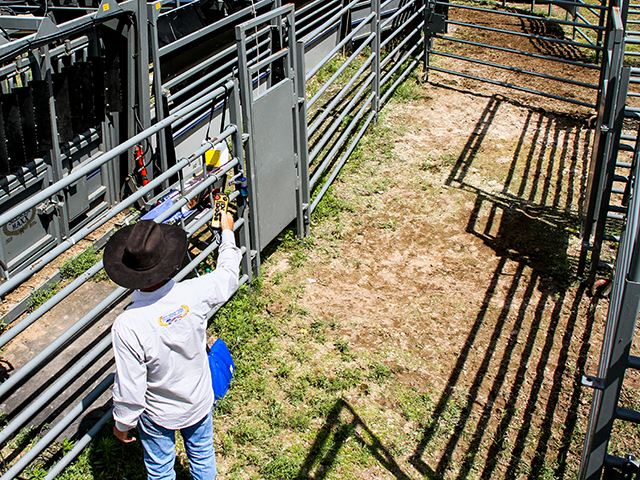Remote Handling Systems for Cattle
Where's the Remote
Anyone who's ever worked cattle knows the safest place is outside the gate. It only takes a second for a misstep to turn into a serious injury. Even cattle accustomed to being handled can be unpredictable if panicked.
Veterinarian Scott Randolph, of Lyons Veterinary Clinic, Lyons, Kansas, says they added a Moly Manufacturing hydraulic Silencer chute with a remote TurretGate and Alleyway about five years ago out of concern for the safety of associate veterinarians and technicians. This system uses a patented gate design that shuttles back behind waiting animals and eliminates the need to swing the gate back open into waiting animals.
"A lot of my associate veterinarians are young women, and I wanted to do all I could to add to the safety aspect of our operation," he explains. "Having a remote TurretGate, Alleyway and Silencer hydraulic cattle chute makes it safer for us, and it adds to the animal-welfare aspect of handling cattle. There is less pushing them forward, and they don't all bunch up trying to crowd their heads together."
Randolph says their system is designed to sort three to five cattle at a time, bringing them through the alley into the chute. While it's primarily used for cattle, he once used the system to help treat a camel.
LOVE OF CATTLE
Lacey Mollhagen grew up in her family's sixth-generation row-crop and cow/calf business at Lorraine, Kansas. She is a key part of the custom cattle-handling equipment business her dad, Jon Mollhagen, started, known by most in the cattle industry as Moly Manufacturing.
Lacey says their on-farm handling facilities are custom-built, and they use the same products they research and develop for others. She says more people are turning to remote handling facilities because of the increasing challenge of finding experienced employees.
"It's hard to find experienced help today, and if we do, they often move on as life changes," she continues. "COVID-19 took that to another level. That is just the industry today. It's expensive to hire people, and you have to add in the safety factor. You can't afford for anyone to get hurt."
P[L1] D[0x0] M[300x250] OOP[F] ADUNIT[] T[]
Remote handling systems can go a long way toward offsetting those challenges. There is a YouTube video, Lacey laughs, of her 94-year-old grandma loading the tub while the family works cattle.
"Believe me, all of my grandparents get out there, press the buttons and keep a nice flow of cattle coming for us," she adds. "It's not all that unusual, though, because we all know the cattle business is a family business. It takes three generations to get the job done sometimes."
THE ANIMAL-WELFARE SIDE
There's another aspect of remote handling that is especially important as the industry emphasizes Beef Quality Assurance (BQA) practices. Remote handling is proven low-stress handling.
Lacey says they continue to be inspired by Colorado State University's Temple Grandin, a world-renowned scientist in animal behavior and handling-system design. She has helped them see handling facilities as cattle would see them.
"Having her dig into this topic is just amazing. It's so important to remember we are predators to these animals, and that will never change. When you can keep your distance and not pressure or push cattle into high-impact areas, it's better. They see a moving wall with a remote TurretGate, and that is much lower stress than having a predator behind pressuring them."
William Hollenbeck has seen the difference firsthand. A research assistant and stocker unit manager at Kansas State University, he says not only do cattle respond to remote handling differently, the systems also make the job much safer for people.
"What I've seen is that cattle are less apt to panic in this type of system," Hollenbeck explains. "It's important to draw the distinction that you can excite an animal but not panic it. Once that line is crossed into a panicked state, it doesn't matter if that animal's nature is docile or excitable, bad things can happen."
He says the remote TurretGate and Silencer hydraulic chute system is about the animal always moving away from pressure. This uses animal psychology, and where labor is limited or unskilled, it may prove to be the better approach. "Here, the animal is always allowed to move forward. You never train the animal to turn around and come back at you. I always want the cattle I am working to have a feeling they can escape, because that's safer for me."
INEXPERIENCED HANDLERS
The remote handling system has been at the beef unit where Hollenbeck works for more than 10 years. It's seen more than 30 undergraduate employees, most without handling experience. All have learned how to operate it, and no one has been injured.
"One of the advantages of this, then, is you can have inexperienced handlers come in and help, and with just a little coaching, you know they won't get hurt," he says. And as for price concerns, Hollenbeck believes if a remote system is replacing a hired hand and removing liability and health insurance for that individual, it is often an investment many can pencil out.
"It's a matter of not only protecting but of managing our assets correctly," he says. "We can't live in this third-world wooden chute and corral system anymore, because we don't have the labor to make that work efficiently and safely."
**
-- Follow Vicki on Twitter @myersPF
[PF_0122]
(c) Copyright 2022 DTN, LLC. All rights reserved.




